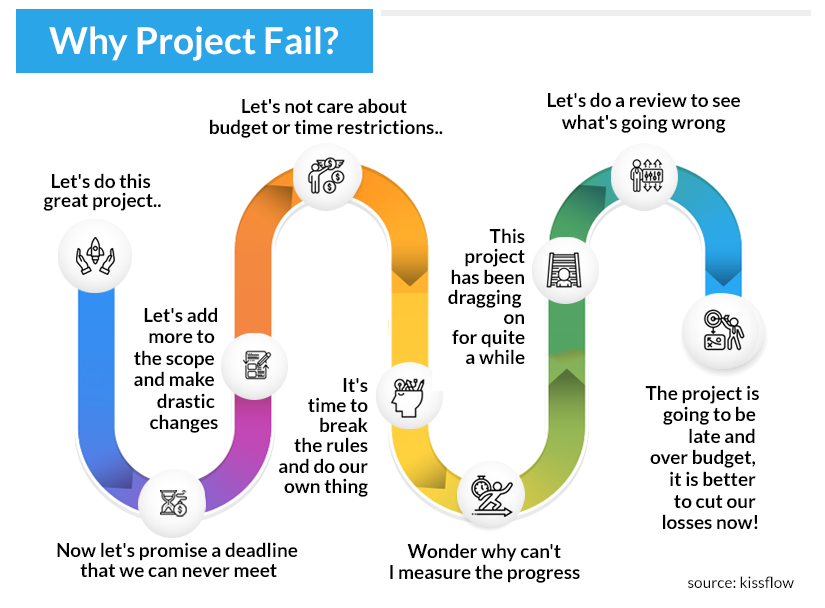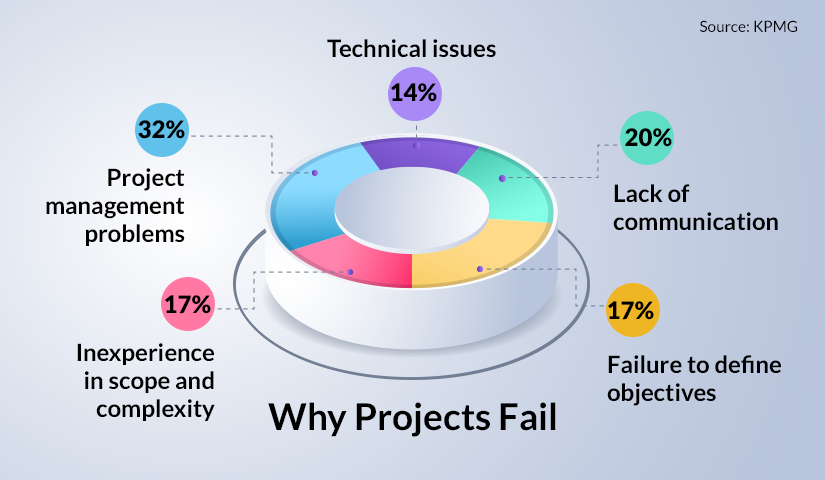Why Implementations Often Cost Millions and Take 18 Months or More?

Picture this. You finally decide on an insurance software and are excited to transform your company’s processes with it. You’ve got your budget approved and set a clear project timeline. The twin benefits of digitization and automation are right around the corner! But, before you realize it, scope creep has set all those careful plans to naught. Now your ‘go-live’ date is months beyond the original project management timeline.
While this may sound like a worst case scenario, the harsh reality is that insurance implementation can often take upwards of 18 months and cost more money than anticipated. However, this does not have to be the case. Quick implementation of insurance software boils down to one thing: efficient planning.
Why Project Timelines aren’t met
This scenario is more common than you would expect

Also Read: New Policy Management Software: The guide to getting it right
What Reasons Cause Project Failure?
-
Not defining your requirements leads to scope creep
Before you begin implementing your chosen insurance software provider, set clear objectives and goals.
- What do you plan to achieve by the implementation?
- What gaps are currently there in your internal process that you want the software to fix?
Starting out with a well defined roadmap will help you narrow down what your requirements are and what features are actually needed. If you start the project without this vision, you can often be tempted by extraneous services that you don’t actually need. Oftentimes ‘one additional feature’ might be added on to the initial project scope. But if such ‘small’ inclusions start to add up, you begin to realize you have exceeded your budget. This is what is known as a ‘scope creep’ and is one of the most common reasons for project failure.
Scope creep is one of the most common reasons for project failure
-
Not identifying a strong Project Champion
Implementation of a new insurance software requires a complete overhaul of the current processes. Depending upon the technological maturity of the organization, it might even require new infrastructure to be set up and old ones to be retired. This coupled with the costs associated with implementation can make insurance companies averse to change.
The project champion is the person within an organization and is from senior management who ensures everyone involved is on board and behind the ultimate success of the project.
A strong project champion can look past these short-term challenges and understand the long-term benefits of investing in the right insurance software. They are critical for getting approval of the implementation, finalizing the budget and securing the resources necessary to make the project a success. The project advocate also defines the end-goals and objectives of the implementation, which will help guide all decisions that need to be made.
-
Not including all parties affected by the implementation
A fully-integrated insurance software will typically include features for various departments, and can be from your agents, to your accounts team and ultimately, your leadership team. But unless each of these teams are involved in the actual implementation of the software, they might not find it very useful for their needs.
When implementation is done without consulting the teams who will be using it, multiple critical features can get missed out. These will have to be added on in later stages, often at a higher cost. Ultimately this will extend your overall project management timeline. To avoid this, it’s essential that you have all your teams involved on a common project management software to help finalize the list of features that the insurance software needs to have.
-
Not consulting Subject Matter Experts on the design
The Jedi had their Yoda, the Teenage Mutant Ninja Turtles had Splinter and software development teams have their subject matter experts. An SME is a person with expert knowledge about what it takes to do a particular job. This can be more than one person depending on the specializations required to design the solution. The subject matter expert might be an internal employee who has the specialized insight or it can be an external consultant contracted to advise the company on a technical practice. Often insurance software providers have years of industry expertise and the latest technological know-how through their experience of having worked with multiple insurance companies. They have the knowledge of what features, customizations and layouts will provide the maximum benefits for your company’s requirements.
Also read: Is Your Tech Stack Holding You Back from a Full Digital Transformation?
-
Lack of proper communication
Communication is the bridge that brings together the various teams working on implementation. Without proper communication, there will not be visibility into the status of the implementation, pending action items or any decisions that need to be taken. This will lead to unnecessary delays which will accumulate and lead to the implementation missing the fixed project timeline.
To prevent communication gaps, it’s important to set guidelines on what platform all communication will be carried out, what project management software will be used for team task management and what the expected deadline to address all comments is.

-
Lack of identified decision-making process
Having a centralized project management software is only one side of effective communication. The other part of team task management is determining who has ownership over what aspect of the implementation.
While there will be a project manager spearheading the project, at the execution level, there needs to be one decision-maker for every stage of the process. One of the common reasons for project failure is project managers having to follow up on every minute aspect of the implementation, which can stall the process. It’s also important that you put in place clear frameworks and parameters for decision making within your team task management plan. Leaders at each level need to have a complete understanding of the objectives, budgets and project timelines so that they can align their decisions around these goals.
-
Not equipping your team with the required skill sets
The initial software implementation is completed and it looks like you’re ready to go! But before you can start reaping the benefits of higher productivity and efficiency, there’s one critical issue: your employees do not know how to use the software. Using a new software requires your employees to learn what the new workflows are and how to use the dashboards. Depending upon the system you are moving from, they might need a complete retraining.
Unfortunately, training time is often not included in the implementation timeframe and this can lead to unforeseen delays in getting the new solution off the ground. Proper training also ensures that your team actually uses the new software properly, so you can gain the full benefits of investing in it.
The high costs and long implementation time of insurance software can be a deterrent for companies looking to make the investment. This is why it is critical to discuss with the insurance software provider upfront what the fixed implementation deadline and cost will be.
“Give me six hours to chop down a tree and I will spend the first four sharpening the axe.” - Abraham Lincoln
SimpleSolve invests time in the planning stage and defining the project scope boundaries. We also have complete transparency in our pricing plans. There are no hidden fees or extra charges that can lead to unplanned expenses.
Topics: Workflow Management








.jpg)

